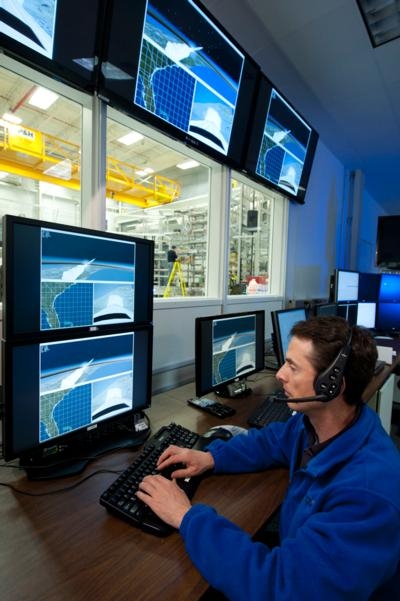Tue, Jan 14, 2014
'First Light' Milestone Reached At Marshall Space Flight Center
The modern avionics system that will guide NASA's Space Launch System (SLS), the most powerful rocket ever built, has seen the light. The flight software and avionics for SLS were integrated and powered for testing Thursday at NASA's Marshall Space Flight Center in Huntsville, AL, as part of a milestone known as first light.

The milestone enables early integration and testing of avionics and software to help NASA perfect the system and ensure the units communicate together as designed. Avionics tell the rocket where it should fly and how it should pivot its engines to stay on course. "We continue to make good progress developing SLS," said Dan Dumbacher, deputy associate administrator for exploration systems development at NASA Headquarters in Washington. "The avionics are like the central nervous system for the launch vehicle. They’re of critical importance and testing them early helps us build a more robust rocket."
The SLS avionics and the flight computer will be housed in the rocket's core stage. When completed, the core stage will be more than 200 feet tall and store cryogenic liquid hydrogen and liquid oxygen that will feed the rocket's RS-25 engines.
The first SLS flight test, targeted for 2017, will feature a configuration for a 77-ton lift capacity and carry an uncrewed Orion spacecraft beyond low-Earth orbit to test the performance of the integrated system. As the SLS evolves, it will provide an unprecedented lift capability of 130 metric tons (143 tons) to enable missions even farther into our solar system to places such as to an asteroid and Mars.
The Boeing Company, prime contractor for the SLS core stage and its avionics, delivered the flight computers and supporting avionics hardware. NASA's Integrated Avionics Test Facilities team provided and installed the structure and simulation capability to model the environments the vehicle will experience during launch. With the avionics hardware units arranged in flight configuration on the structure and with the flight software, the facility will replicate what will actually fly the rocket.
(Pictured: NASA test engineer James Peckham runs an avionics flight simulation to see how SLS will perform during launch)
More News
“These new aircraft strengthen our ability to respond quickly, train effectively and support communities nationwide. Textron Aviation has been a steadfast supporter in helpin>[...]
From 2011 (YouTube Edition): Rugged, Legendary, STOL Twin Makes A Comeback The de Havilland Twin Otter is an airplane with a long history, and it gained a reputation as a workhorse>[...]
A Wind Gust Lifted The Right Wing And The Airplane Turned To The Left Analysis: The pilot was departing from a 2,395-ft-long by 50-ft-wide turf runway. The pilot reported that afte>[...]
Have A Story That NEEDS To Be Featured On Aero-News? Here’s How To Submit A Story To Our Team Some of the greatest new stories ANN has ever covered have been submitted by our>[...]
Braking Action Advisories When tower controllers receive runway braking action reports which include the terms “medium," “poor," or “nil," or whenever weather con>[...]
 Aero-News: Quote of the Day (12.18.25)
Aero-News: Quote of the Day (12.18.25) Classic Aero-TV: Viking Twin Otter 400--Bringing the DHC-6 Back Into Production
Classic Aero-TV: Viking Twin Otter 400--Bringing the DHC-6 Back Into Production NTSB Final Report: Rans Employee Flying Club Rans S-6ES Coyote II
NTSB Final Report: Rans Employee Flying Club Rans S-6ES Coyote II ANN FAQ: Submit a News Story!
ANN FAQ: Submit a News Story! ANN's Daily Aero-Term (12.18.25): Braking Action Advisories
ANN's Daily Aero-Term (12.18.25): Braking Action Advisories



